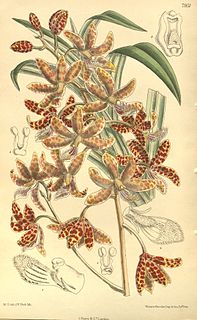Related Research Articles

Dipodium, commonly known as hyacinth orchids, is a genus of about forty species of orchids native to tropical, subtropical and temperate regions of south-east Asia, New Guinea, the Pacific Islands and Australia. It includes both terrestrial and climbing species, some with leaves and some leafless, but all with large, often colourful flowers on tall flowering stems. It is the only genus of its alliance, Dipodium.

Dipodium punctatum, commonly known as the blotched hyacinth-orchid, is a leafless orchid that is a native to eastern and south-eastern continental Australia. In summer it produces a tall flowering stem with up to sixty pale to bright pink flowers with heavy red blotches. A widespread and common species it is often confused with D. roseum and some authorities regard it as a synonym of D. squamatum.

Dipodium roseum, commonly known as rosy hyacinth-orchid or pink hyacinth-orchid, is a leafless saprophytic orchid found in east and south-eastern Australia. In summer it produces a tall flowering stem with up to fifty pale pink flowers with small, dark red spots. A widespread and common species it is often confused with D. punctatum but has darker, less heavily spotted flowers.

Dipodium pardalinum, commonly known as spotted hyacinth-orchid or leopard hyacinth-orchid, is a leafless hemiparasitic orchid that is endemic to south-eastern Australia.

Dipodium variegatum, commonly known as the slender hyacinth-orchid, or blotched hyacinth-orchid, is a leafless mycoheterotrophic orchid that is endemic to south-eastern Australia. It forms mycorrhizal relationships with fungi of the genus Russula.
Dipodium campanulatum, commonly known as the bell-flower hyacinth orchid, is a leafless mycoheterotroph orchid that is endemic to south-eastern Australia. In summer it has up to thirty five white flowers with large, dark red spots and blotches.

Dipodium stenocheilum, commonly known as tropical hyacinth-orchid, is a leafless saprophytic orchid that is endemic to northern Australia. For most of the year the plant is dormant but in summer it produces a tall flowering stem with up to twenty five white flowers with purple spots and a mauve labellum.
Dipodium fevrellii is an orchid species that is endemic to Sulawesi in Indonesia. The species was formally described in 1933 by Dutch botanist Johannes Jacobus Smith.
Dipodium bicallosum is an orchid species that is native to Peninsular Malaysia and Sumatra in Indonesia. The species was formally described in 1927 by Dutch botanist Johannes Jacobus Smith.
Dipodium parviflorum is an orchid species that is native to Peninsular Malaysia and Sumatra in Indonesia. The species was formally described in 1911 by Dutch botanist Johannes Jacobus Smith.
Dipodium purpureum is an orchid species that is native to Borneo. The species was formally described in 1910 by Dutch botanist Johannes Jacobus Smith.
Dipodium conduplicatum is an orchid species that is native to Peninsular Malaysia and Sumatra. The species was formally described in 1927 by Dutch botanist Johannes Jacobus Smith.

Dipodium ensifolium, commonly known as leafy hyacinth-orchid, is an orchid species that is endemic to north-east Queensland. It has sword-shaped leaves and up to twenty pink to mauve flowers with purplish spots and blotches.

Dipodium pictum, commonly known as brittle climbing-orchid or climbing hyacinth-orchid, is an orchid species that is native to Malesia and the Cape York Peninsula in Australia.

Dipodium atropurpureum, commonly known as the purple hyacinth orchid, is an almost leafless mycoheterotrophic orchid that is endemic to New South Wales. In summer it has up to forty dark pinkish purple to reddish purple flowers with darker spots and blotches on a tall flowering stem.
Dipodium fragrans is an orchid species that is native to south-east Asia. It was formally described in 2006. It occurs in Sumatra, Peninsular Malaysia, Borneo and Sulawesi.

Dipodium paludosum is an terrestrial orchid species that is native to south-east Asia. It occurs in Cambodia, Thailand, Vietnam, The Philippines, Sumatra, Peninsular Malaysia and Borneo. The leaves up to 30 cm long and 2.5 cm wide. The axillary racemes comprise 6 to 12 fleshy flowers which are each up to 4 cm wide and are cream with purple-magenta spots.
Dipodium pulchellum is an almost leafless orchid that is endemic to north-east New South Wales and south-east Queensland in Australia. Up to forty pink flowers with darker blotches are borne in summer and winter on flowering spikes up to 90 cm (40 in) long.
Dipodium scandens is an orchid species that is native to Malesia.
Dipodium squamatum is a mycoheterotrophicorchid species of the tribe Cymbidieae.
References
- ↑ "Dipodium brevilabium Metusala & P.O'Byrne". The Plant List version 1.1. Retrieved 29 January 2013.
- ↑ "Dipodium brevilabium Metusala & P.O'Byrne, Orchid Rev. 117: 151 (2009)". World Checklist of Selected Plant Families. Retrieved 29 January 2014.